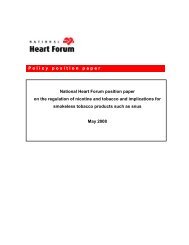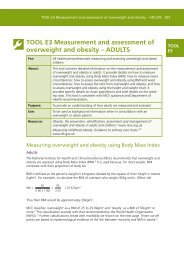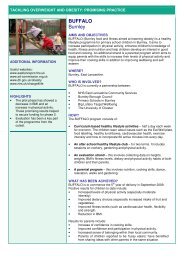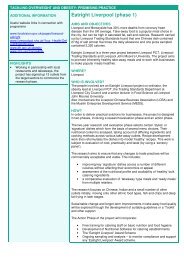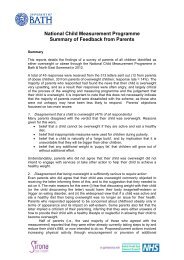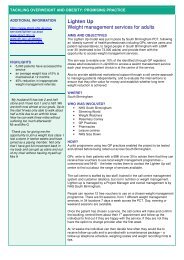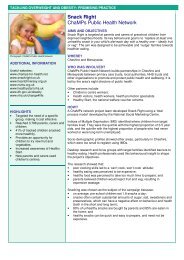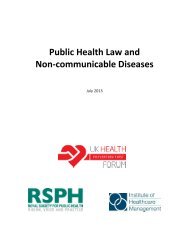The Challenge of Non-Communicable Diseases and Road Traffic ...
The Challenge of Non-Communicable Diseases and Road Traffic ...
The Challenge of Non-Communicable Diseases and Road Traffic ...
Create successful ePaper yourself
Turn your PDF publications into a flip-book with our unique Google optimized e-Paper software.
68 <strong>The</strong> <strong>Challenge</strong> <strong>of</strong> <strong>Non</strong>-communicable <strong>Diseases</strong> <strong>and</strong> <strong>Road</strong> <strong>Traffic</strong> Injuries in Sub-Saharan Africa<br />
Improving information systems <strong>and</strong> links between<br />
police, transport, <strong>and</strong> health service data improve<br />
data quality; for example, capturing figures for those<br />
who die after admission to hospital <strong>and</strong> triangulation<br />
<strong>of</strong> sources helps to confirm trends <strong>and</strong> identify<br />
data problems. Figure 22 illustrates a data management<br />
system for road safety. <strong>The</strong> health sector also<br />
needs to be better at collecting data on non-fatal<br />
injuries in a st<strong>and</strong>ardized way as this can guide resource<br />
allocation [480]. Collecting data on motorcycle<br />
helmet-wearing <strong>and</strong> seatbelt-wearing can indicate<br />
success <strong>of</strong> measures, <strong>and</strong> estimates <strong>of</strong> costs to<br />
the health system <strong>and</strong> economy can help advocacy<br />
<strong>and</strong> decisions about enforcement efforts.<br />
Research Gaps<br />
Research gaps exist for NCD prevention <strong>and</strong> control<br />
in Africa. Priority areas for research include<br />
epidemiological surveillance, primary <strong>and</strong> secondary<br />
prevention, <strong>and</strong> adaptation <strong>of</strong> health system responses<br />
[481]. National <strong>and</strong> international efforts are<br />
needed to develop resource-appropriate strategies<br />
<strong>and</strong> create “frugal innovations”, such as low-cost radiation<br />
therapy. Given the need for a health care system<br />
that can cope not just with acute care but with<br />
chronic care needs effectively, it may be useful to explore<br />
the further development <strong>of</strong> appropriate tools<br />
to help model NCD/communicable disease combi-<br />
FIGURE 22: Systemic Use <strong>of</strong> Data for <strong>Road</strong> Safety Planning, Monitoring, <strong>and</strong> Evaluation<br />
R E S U LTS<br />
Social Costs<br />
(direct <strong>and</strong> indirect)<br />
Crashes, Injuries <strong>and</strong> deaths<br />
(final outcomes)<br />
Operational conditions <strong>of</strong> the road traffic system<br />
(intermediate outcomes)<br />
Outputs<br />
(interventions implemented)<br />
Data<br />
Data<br />
Data<br />
Data<br />
Costs:<br />
Medical costs, material <strong>and</strong> intervention<br />
costs, productivity losses, traffic jams<br />
(lost time) loss <strong>of</strong> life/quality <strong>of</strong> life<br />
Outcome Indicators:<br />
Crashes, injuries, deaths,<br />
(combined with exposure data)<br />
Safety performance Indicators:<br />
Speed, alcohol, restraints,<br />
helmets, road infrastructure,<br />
vehicle safety, trauma management<br />
Process/Implementation indicators:<br />
<strong>Road</strong> safety policies, plans, programmes,<br />
implementation <strong>of</strong> interventions.<br />
Interventions<br />
<strong>Road</strong> safety management functions<br />
Coordination<br />
Legislation<br />
Funding,<br />
resource<br />
allocation<br />
Promotion<br />
Monitoring<br />
<strong>and</strong> Evaluation<br />
R&D <strong>and</strong><br />
knowledge<br />
transfer<br />
Source: [480]



